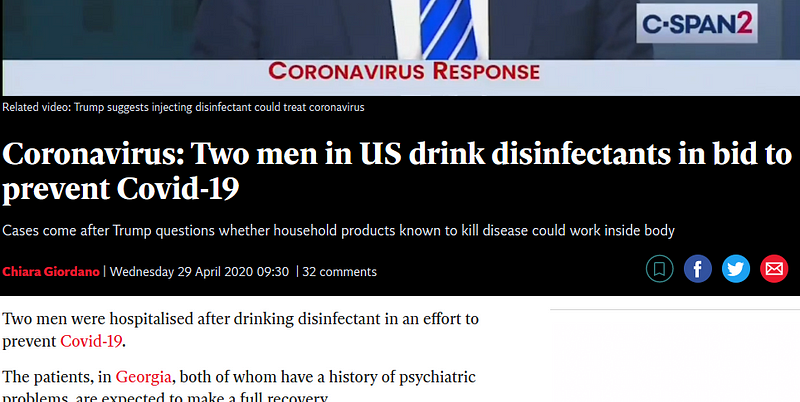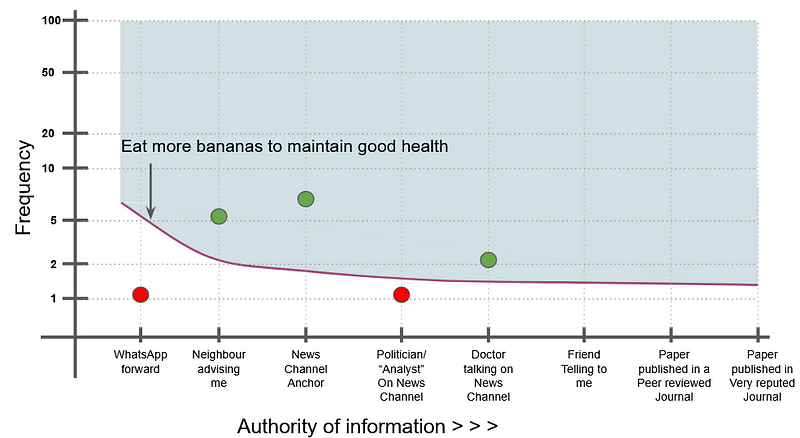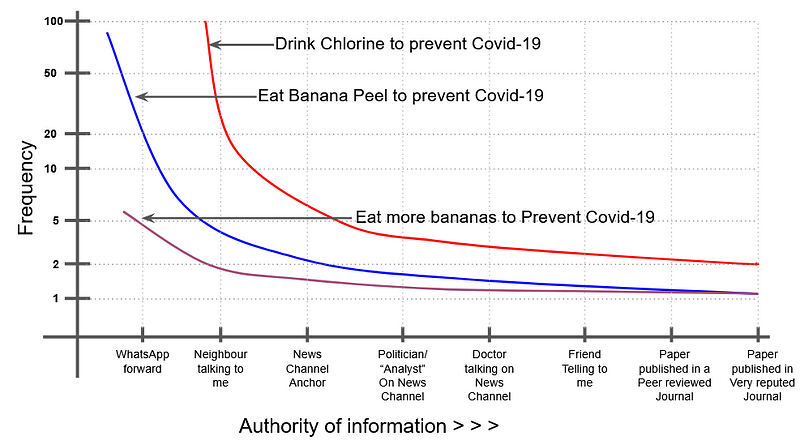“There are people, who drank bleach to cure coronavirus!!! What a bunch of idiots. I mean how dumb one has to be, to actually do something so dangerous just because someone on the internet suggested it.” I thought, as I prepare to snort chilli powder to get rid of acne. I heard about the ‘snorting chilli powder to clear acne’ thing on a tim ferriss podcast, so I HAD to try it.

Then I thought, What would it take for me to actually drink bleach say, to cure cancer or covid-19? Will I do it if I hear it on another episode of tim ferriss podcast? No. Will I do it if someone on a news channel said that it is completely safe and effective? Probably Not. What if there are 7 papers published in some highly reputed Scientific Journal about benefits and lack of harm of drinking bleach? well, probably 😐.
Ideally, there should be three main factors that should go into deciding if you will act on a new piece of information you just received.
- What is the perceived benefit of the action? ( Protection from Covid-19 — Very high benefit)
- What is perceived downside/risk of doing it? (poisoning yourself — High risk -> if you know what bleach exactly is)
- What is the effort required? (drinking bleach — Low effort)
Of course, in the real world many other rational and irrational factors come into play in decision making like social pressure, alternatives for the action, your emotional state, etc. But one factor I want to concentrate here on is the trust you have on the sources of information about the 1st and 2nd Question above. The perceived benefit and the perceived downside of the action.
Two factors that go into this kind of trust are 1) The inherent trust you have in a source of information and 2) The frequency with which the information in repeated.
Say, there is a rumor floating around that eating a banana peel everyday helps prevent Covid -19. One is more likely to actually eat a banana peel if he sees the information on a news channel than if he sees the information shared in some facebook group. A news channel is obviously more trusted by people than a random facebook group.
One will not eat a banana peel if he sees the benefits listed on one facebook group. But, what if the benefits are listed on 10 different groups? I am willing to bet the person is more likely to eat a banana peel in the second case. The more you hear something, the more you believe it. I am not even making this up(unlike rest of this blog) this phenomenon has been clinically observed.
We can use this kind of reasoning to make a badly approximated Pareto graph of some sorts. I call these curves, “Influence Curves” Where X axis is sources of information arranged in increasing level of trustworthiness and the Y axis is the frequency with which the information is repeated

Suppose, The above figure is Ram’s Pareto graph for eating more bananas then any point that lies “above” the purple curve will make me eat a banana. Any point below wont. So, all the incidents involving the green dots(2 doctors on news, 7 News Anchors or 5 Neighbor talking) will make me eat more banana. But getting just 1 whatsapp forward or facebook post wont convince him to eat more banana.
A Pareto chart with a bit more influence curves might look something like this.

For a given person, where the shape of influence curve might depend on the reward/risk ratio of the action. If the risk is too high and reward is too low, someone will have to put in a lot of effort to convince me to do it. So, a curve for “drink chlorine for better sleep” will be very high. Conversely if the reward is high enough and the risk is low, I will readily do it. A curve for “drink lemonade to prevent cancer” will be pretty low. The risk is virtually nothing and the potential reward is very high.
In the figure above, the reward for all three curves is same, preventing covid-19. But, the lower the risk, the lower will be the curve. The curve for eating more banana is lowest it can get while that about drinking chlorine is pretty high up.
Again, the actual decision making process is very complex phenomenon about which I know nothing. But I hope this influence curve model might helps us explain some behavior.
People are not idiots
Using this we can now see why someone might actually consider drinking bleach just because they heard about it in some speech on tv. Let’s look at some of the factors that will go into the influence curve.
- Reward: If there are people who think covid-19 is just another flu, then there must be people on the other end of spectrum as well. People who think the virus is basically a kiss from death. For these people, the potential for preventing Covid-19 is a Huge reward
- Risk: The perceived risk of drinking bleach depends on things like do you know what bleach is?, do you know how human digestion works?, do you remember your basic science class?
- Trust order of Information sources: This is deeply personal topic. Someone might trust a politician speaking on air much more than they trust a science teacher in their neighborhood. The order in which things line up on horizontal axis of a influence chart can be very different person to person.
Now for someone with highly skewed reward/risk ratio about bleach and coronvirus, and slightly unconventional trust order for information source, just a speech by a politician or news anchor might just be above the influence curve.
Note: Drinking bleach during a pandemic is not the only “crazy” thing people do that can be analyzed here. Few things that happened closer to home that can very well be looked at(eg. the gomutra cures coronavirus thing from march). But, analyzing something happening more than 10,000 KM away helps you look at the situation a bit more objectively and drinking bleach is just crazy enough to make a good title.